North Macedonia’s FIFA World Ranking (62) makes them the biggest outsiders for UEFA EURO 2020. Their underdog status won’t put a damper on their achievement of qualifying, however, as EURO 2020 will be the first time that this independent republic competes at a major tournament since its secession from Yugoslavia in 1991.
This summer’s North Macedonian squad will have the opportunity to join Blagoje Vidinić – the only player of North Macedonian origin to have ever played in the European Championships, which he achieved as runner-up Yugoslavia’s goalkeeper in 1960.
The southeastern European underdogs qualified for the tournament via play-off Path D, overcoming Kosovo 2-1 in the semi-final before beating Georgia 1-0 in a cagey final thanks to captain, legend and national hero Goran Pandev’s 56th-minute goal – a strike that’s been declared the most important in North Macedonia’s history.
In this tactical analysis, in the form of a scout report, we’ll provide a comprehensive analysis of Igor Angelovski’s squad, the tactics that the 44-year-old manager successfully deployed to help his country qualify for the Euros, and a preview of the tactics we anticipate they’ll use at this tournament.
THE SQUAD
North Macedonia’s 26-man squad
Goalkeepers:
Stole Dimitrievski
Risto Jankov
Damjan Siskovski
Defenders:
Ezgjan Alioski
Egzon Bejtulai
Visar Musliu
Kire Ristevski
Stefan Ristovski
Darko Velkovski
Gjoko Zajkov
Midfielders:
Arijan Ademi
Daniel Avramovski
Enis Bardhi
Darko Churlinov
Eljif Elmas
Ferhan Hasani
Tihomir Kostadinov
Boban Nikolov
Marjan Radeski
Stefan Spirovski
Forwards:
Goran Pandev (c)
Milan Ristovski
Vlatko Stojanovski
Aleksandar Trajkovski
Ivan Trickovski
Krste Velkoski
North Macedonia are packed with technically proficient players. Captain, play-off hero and 2009/10 UEFA Champions League winner with Inter – Pandev – of Serie A side Genoa is of this mould himself, as are playmakers Eljif Elmas of Napoli and Enis Bardhi of La Liga side Levante.
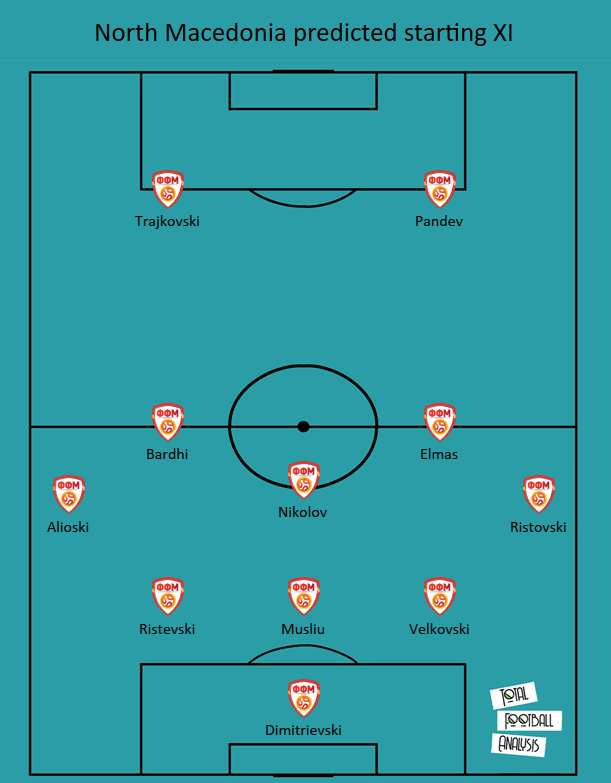
These men, as well as the wing-back pairing of Ezgjan Alioski, from EPL side Leeds United, and Stefan Ristovski from Croat giants Dinamo Zagreb, are some of the biggest names that Angelovski has available for the Euros and as shown in figure 1, we expect all of them to feature in the 44-year-old’s preferred starting XI.
One shape that Angelovski has used throughout his tenure, especially versus strong opposition, is the 3-5-2. So, we predict that Angelovski will opt for his trusty 3-5-2 as plan A in the Euros, versus tough opposition. Stole Dimitrievski has been a regular between the sticks under Angelovski, and we expect him to retain the ‘number 1’ shirt for the Euros. Alioski will likely play at left wing-back with Ristovski at right wing-back. Between them, we predict that Darko Velkovski will play at right centre-back, Kire Ristevski will play at left centre-back, and Visar Musliu will play in the centre of the back three. Egzon Bejtulai and Kristijan Tosevski provide other options for Angelovski at centre-back, however, this trio tends to play when fit and many of Bejtulai’s recent minutes for the national team have seen him deputise at right-back, where Ristovski is likely to play.
The playmaking duo of Elmas and Bardhi will likely occupy two ‘8’ positions in central midfield, alongside either Arijan Ademi, Stefan Spirovski, or – our pick to take the holding midfield position – Boban Nikolov. Nikolov has been a regular member of North Macedonia’s starting XI of late and we feel that’s a good indication of the manager’s feelings on this position. It’s possible that both Nikolov and Ademi/Spirovski play, which could provide more central solidity for this team, but Angelovski has been willing to play the two attacking options, with that decision paying off in a recent 2-1 World Cup qualifier giant killing of Germany.
When he took charge of North Macedonia, Angelovski persuaded the country’s most-capped player and top scorer Pandev to return to national duty. That decision was rewarded, with Pandev playing a vital role in his side’s qualification for EURO 2020. The captain plays a key role in his national team’s offensive tactics, and we expect him to play at right centre-forward. Lastly, Aleksandar Trajkovski, who successfully partnered Pandev for North Macedonia’s recent wins over Germany and Liechtenstein, is our pick to take the left centre-forward position.
Experienced centre-forward options Ilija Nestorovski and Ivan Trickovski could claim a place in the starting XI alongside Pandev, but the Trajkovski-Pandev partnership has been successful recently and their profiles suit the roles that Angelovski likes his centre-forwards to play in this team.
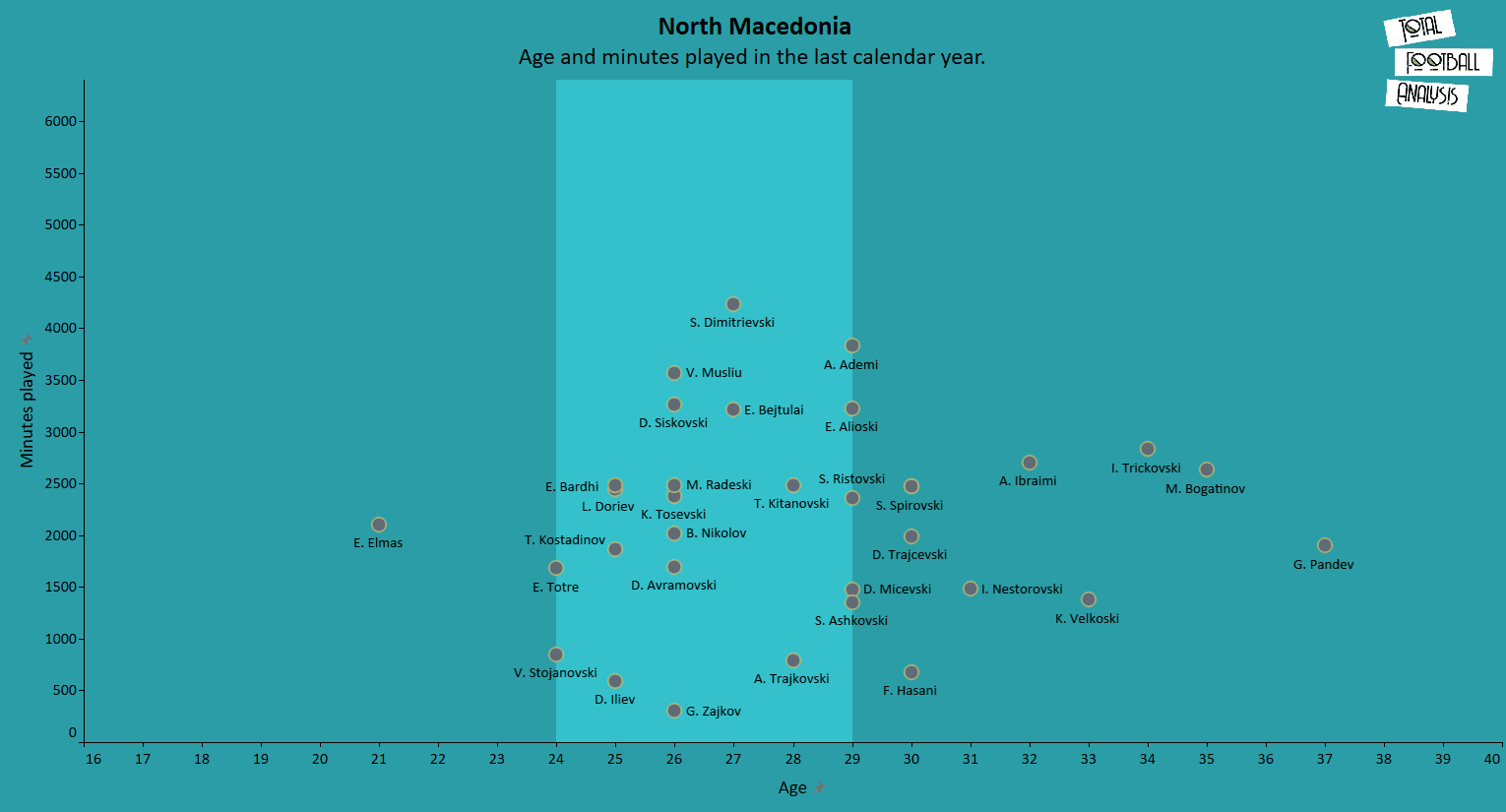
Figure 2 highlights that the vast majority of North Macedonia’s squad are within the ‘peak age’ range of 24-29. This includes Dimitrievski, Ristovski, Alioski, Nikolov, Trajkovski, Musliu and Bardhi, who we expect to play a key role at the Euros. Far more of their squad members, including captain Pandev, are in the experienced range than are in the inexperienced/youth range, with only 21-year-old Elmas featuring as one for the future.
This graph doesn’t make terrific reading for the future of North Macedonian football. This side does desperately need to start looking to the future outside of Elmas, however, to take a more positive look, for those purely concerned with North Macedonia’s chances at Euro 2020, Angelovski will have an experienced group, largely at the height of its power.
ATTACKING PHASE
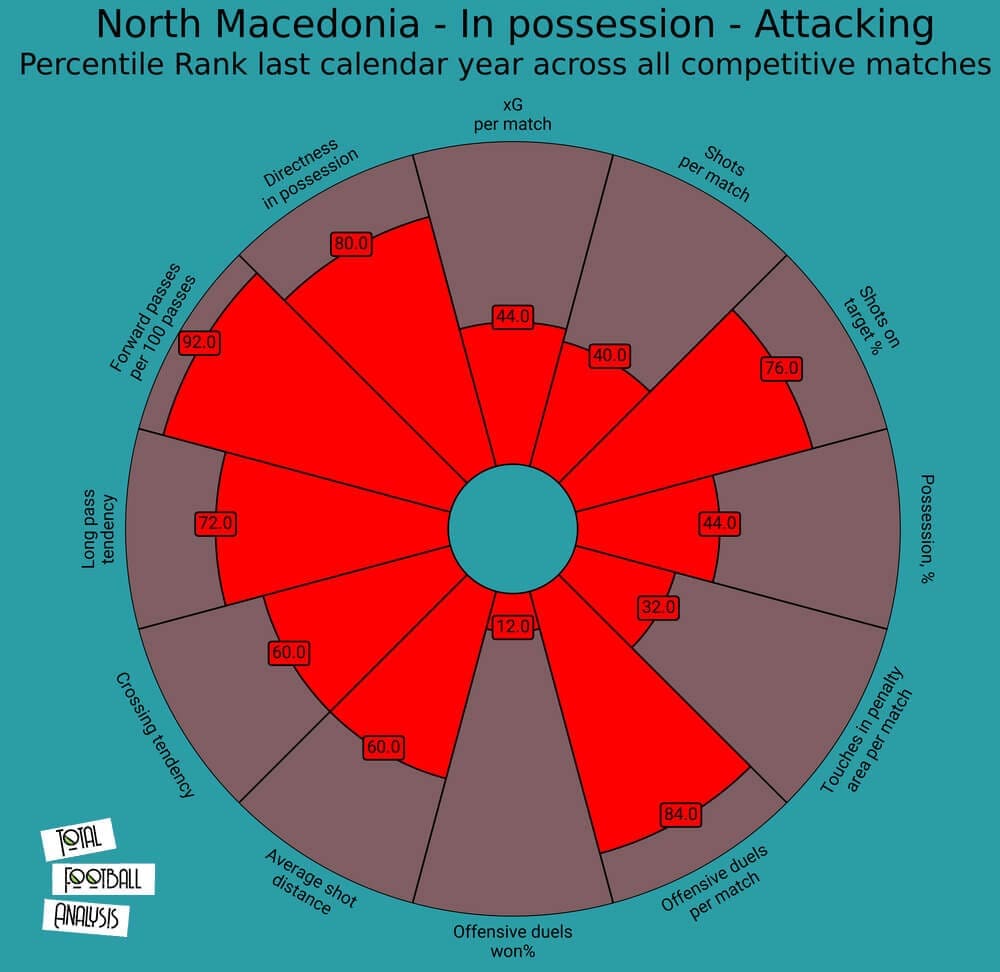
Figure 3 shows us this team’s percentile rank in key offensive areas over the last calendar year. To summarise this, North Macedonia are very direct in possession. They don’t spend a lot of time on the ball, players tend to try and get their team up the pitch and away from their own goal with great urgency. In addition to playing a lot of forward passes, they’re comfortable with going long.
Knowing that North Macedonia don’t pass the ball around laterally much and are keen to get forward quickly, it mightn’t be surprising that they engage in lots of offensive duels, however, their efforts are in vain the vast majority of the time.
They don’t spend much time in the opposition’s penalty area and they don’t create many goalscoring chances, however, they aren’t wasteful with the shots they do take and their lack of time in the opposition penalty area doesn’t lead to them taking many longshots. When they do take shots, they tend to be accurate, indicating that they’re not wasteful in front of goal and largely take shots after having worked to create a good goalscoring chance, though they still fail to create many of them.
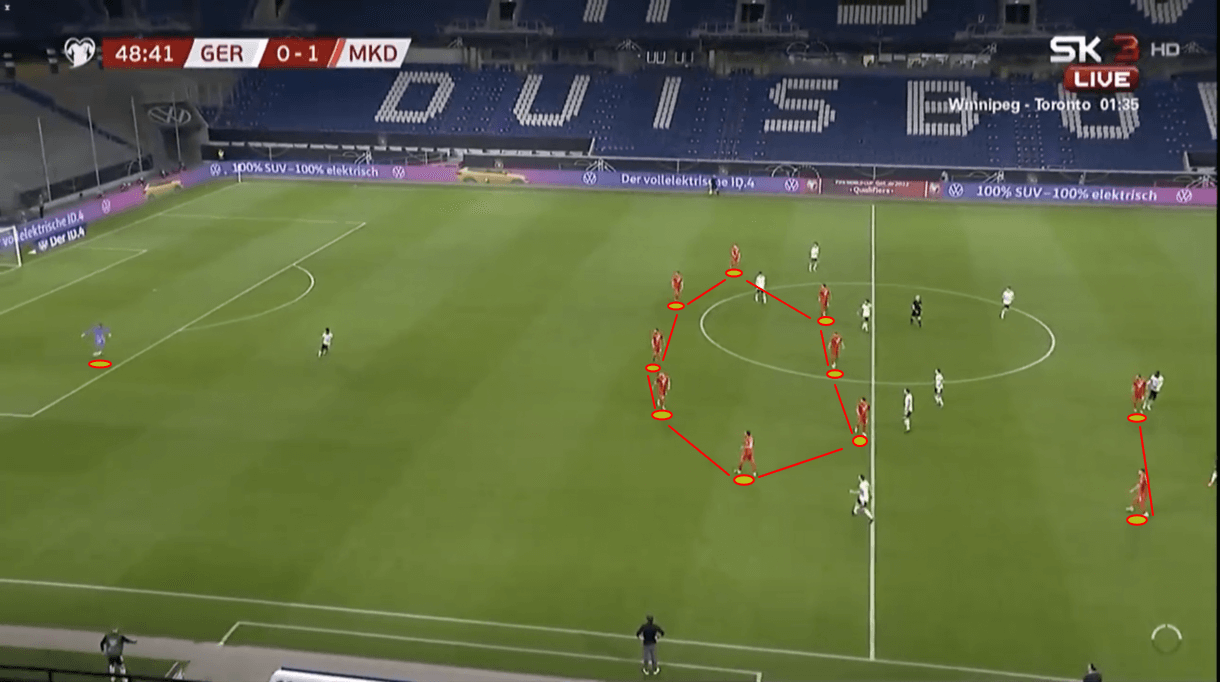
Figure 4 shows North Macedonia’s 3-5-2 offensive shape, with the ball at the feet of goalkeeper Dimitrievski. There’s a large distance between the goalkeeper and the rest of the team, with the back three positioned closer to the halfway line than their own box. It’s common to see North Macedonia go long from the goalkeeper, as was the case here, from either goal-kicks or open play. When this happens, the rest of the team tends to get quite narrow, as we see here, with the centre-backs, wing-backs and central midfielders forming a tight octagon in the middle of the park.
North Macedonia don’t always play with an obvious long ball target. Neither Trajkovski or Pandev are a traditional ‘number 9’. Neither of them are very physical players, and so, North Macedonia often lose the aerial duel resulting from their goal-kick. For that reason, Angelovski’s side tends to focus more on winning the second ball following these aerial duels. In their narrow formation, the nearest players to the forward battling for the ball, such as his strike partner, the near-side central midfielder and near-side wing-back, crowd around the drop zone, ready to pounce on the second ball. If they win it, then they’ll carry the ball forward or play a more advanced player through.
While it’s common to see North Macedonia go long from the goalkeeper, they do sometimes play out short from the goalkeeper to the centre-backs. In these cases, it’s common to see the ball played out to the wide centre-backs, rather than the central one. This player will then look to play a long ball forward, with a similar result as when the ‘keeper launches the ball forward. Generally, their centre-backs’ technical quality isn’t great. When the ball is played to the centre-backs, this can be something for the opposition to target via aggressive pressing, which has proven successful, as these players’ ability on the ball is a notable weakness.
As mentioned previously, North Macedonia have plenty of technical players in attacking positions, like the centre-forwards and 8s. This leads to plenty of intelligent movement and creative short passing sequences inside the final third. This highlights why they’re so keen to get the ball away from their own goal and towards the opposition’s goal quickly. It’s imperative for them to limit their deep-lying players’ time on the ball, and give their technical attackers more time on the ball.
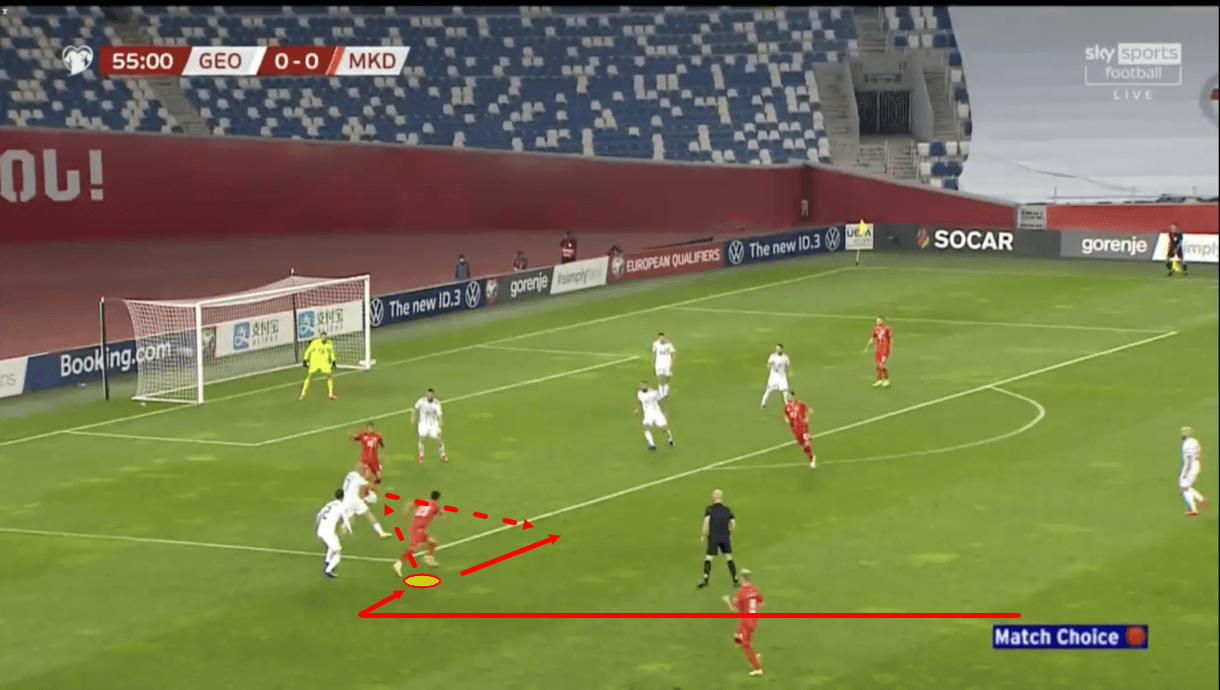
It’s common to see North Macedonia’s 8s link up with the forwards while the wing-backs overlap, which we see in figure 5. In attack, playing without traditional wingers, North Macedonia’s 8s frequently get wide. From here, they either carry the ball forward via the wing or, more commonly, carry the ball inside, linking up with the forwards to exploit the half-space.
When they get into the half-space, they can find the overlapping wing-back, play a through pass to a teammate in the box, or play a cross to the far post. Bardhi and Elmas’ playmaking quality is key to North Macedonia’s tactics. This is why they often play with two 8s, as one is always on that side of the pitch to drift out wide and create, either staying outside or cutting into the half-space.
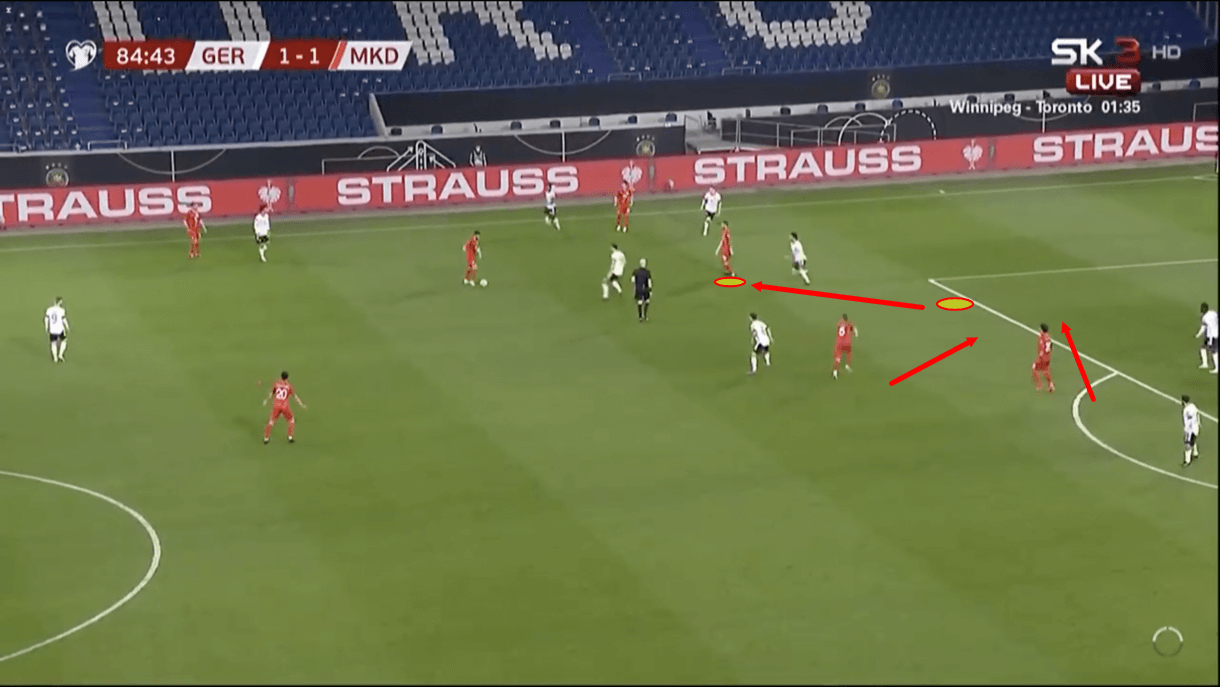
North Macedonia’s centre-forwards’ technical quality is another key element of their offensive tactics. When the ball is on their side of the pitch, it’s common to see a centre-forward drop into the half-space, to either make themselves a passing option for a deeper teammate, or drag an opposition defender out with them, creating space in behind for either their strike partner or the 8 on that side to exploit, as happened in figure 6.
Both centre-forwards act this way. Their movement, combined with their teammates’ movement around them, makes them difficult for the opposition to mark. The centre-forwards’ movement and the 8s’ movement highlights how North Macedonia’s technically proficient attackers are constantly trying to find space in between the opposition’s backline and midfield line. It’s dangerous for these players to have so much room, should they find it, and they can hurt defences of the highest quality, as Germany discovered.
DEFENSIVE PHASE
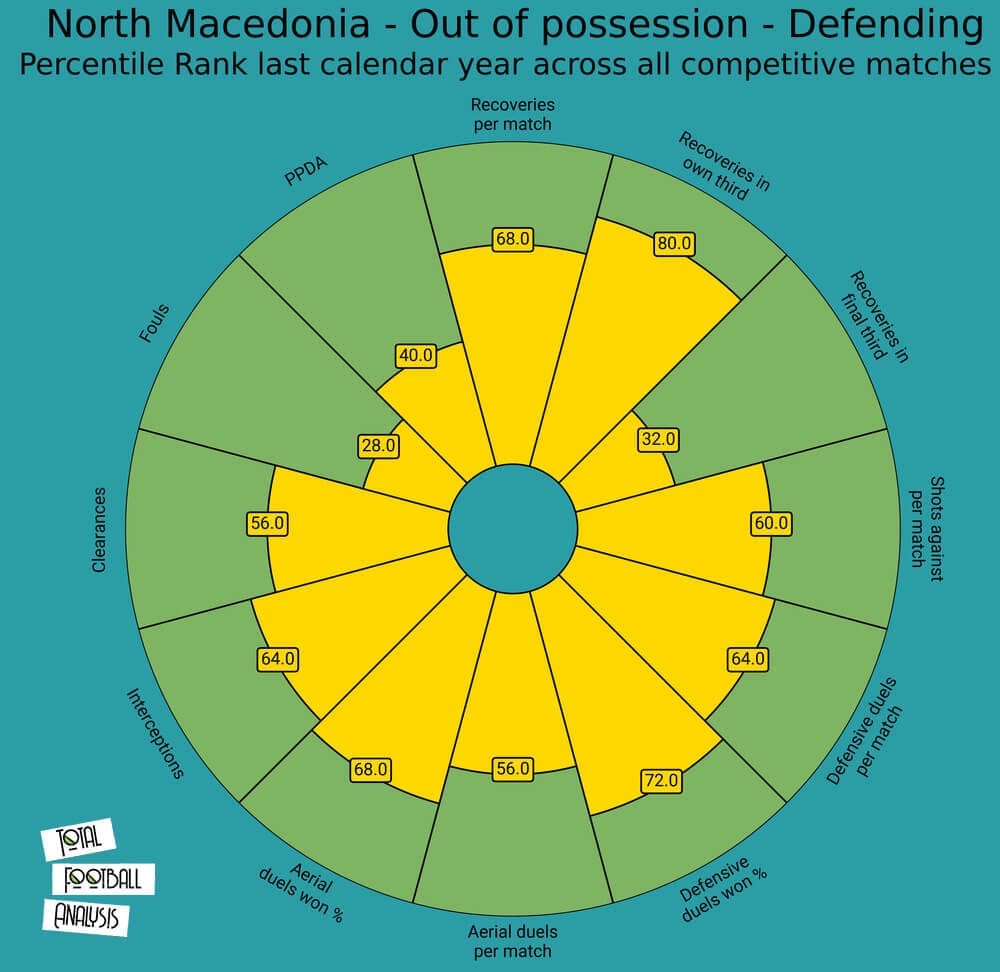
Figure 7 shows North Macedonia’s percentile rank in key defensive areas over the last calendar year. To summarise what this tells us, North Macedonia are a passive team in terms of pressing intensity. They win the ball back a lot, but they do so in their own third far more often than in the final third, where they defend with far less urgency and rarely force turnovers. Additionally, North Macedonia engage in lots of defensive duels, and win lots of them too.
This last point indicates that Angelovski’s side is good at setting up favourable defensive situations for themselves. They are good at creating the defensive duels that they want to engage in, and their success at recovering the ball in these scenarios justifies their tactics. These defensive scenarios typically see North Macedonia drop to the edge of their box in a compact 5-3-2 / 5-4-1 shape before engaging with the opposition to try and retrieve possession.
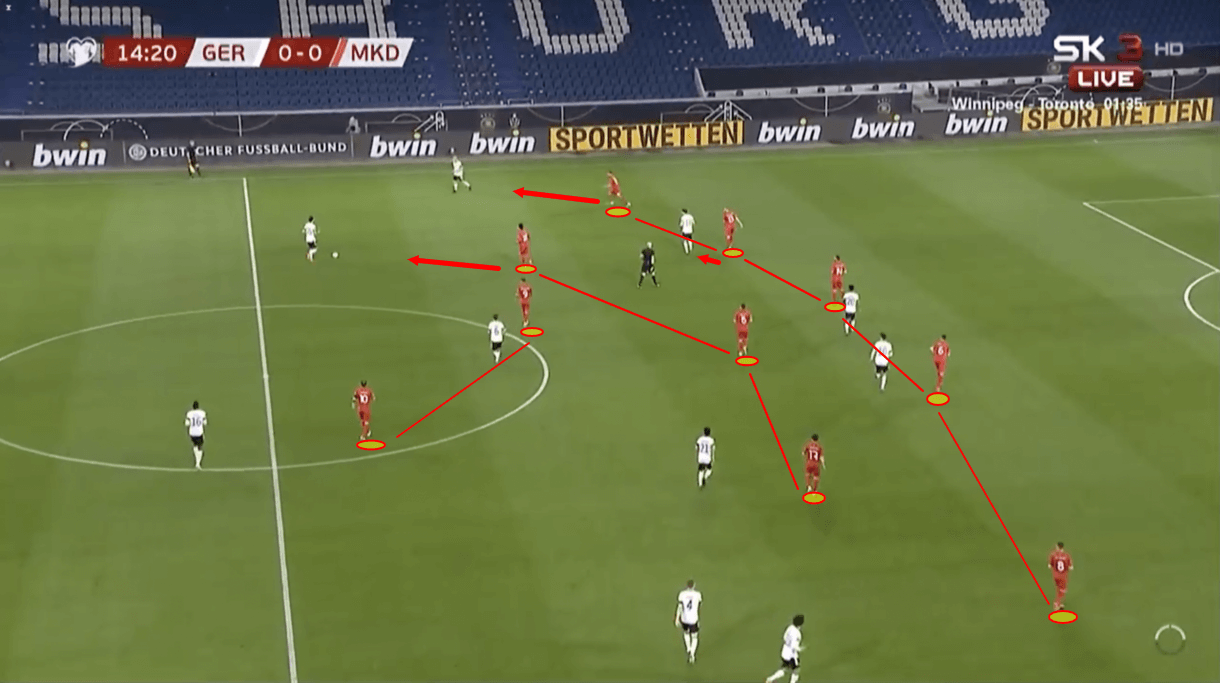
Figure 8 shows North Macedonia in their compact 5-3-2 block, with the opposition having just progressed beyond the halfway line. The wing-backs drop into deeper positions in-line with the centre-backs, while the 8s sit alongside the holding midfielder, with very little space in between the midfield and defensive lines. Additionally, one of North Macedonia’s centre-forwards, in this case Trajkovski, drops from the frontline as the opposition advance. By doing so, he can mark the opposition’s holding midfielder and plug space between the frontline and midfield line. As the opposition continue to advance, this player often drops further, essentially creating a 5-4-1 shape.
North Macedonia don’t typically press aggressively in the opposition half or in the central third. Organisation and discipline are essential to their defensive tactics. They deploy a strict zonal marking system, with North Macedonians picking up opposition players as they enter their zone, but they don’t follow players very far outside of their zone if they drift away. They rely on the compactness of their shape to limit the space these players have to drift into and limit space between players’ zones. In figure 8, we see that North Macedonia’s right centre-back has been drawn to a German player in the left half-space, while North Macedonia’s right central midfielder is focused on Germany’s left centre-back, who’s carrying the ball upfield.
The right central midfielder getting drawn towards the ball-carrier creates space in midfield for Germany to potentially exploit but North Macedonia react with the right centre-forward dropping to cover the right central midfielder and the right centre-back following the German attacker in the left half-space as he drops off, before the right central midfielder drops back into his position as Germany continue to advance. Spaces like this can be exploited if the opposition are quick enough. The North Macedonian centre-backs won’t have as much quality as many of the attackers they come up against this summer and when dragged into 1v1s, they can struggle, so if the attacker in the left half-space did get the ball behind the right central midfielder here, he could’ve caused problems.
This isn’t the defensive scenario that North Macedonia like, or the type they’re so good at setting up, however. As figure 8 showed, it’s more common to see them block off spaces and remain compact before forcing the opposition to pass into a risky area close to the North Macedonian box. This is when North Macedonia’s defenders pounce and usually win back possession. They don’t defend in large areas a lot, nor do they typically defend 1v1 a lot thanks to their compact defensive block. It will be key for them to limit the 1v1 defending scenarios they have to engage in this summer, while it will be key for their opponents to exploit the defensive frailties of their 8s and create 1v1s against the centre-backs.
TRANSITIONS
In transition to defence, North Macedonia try to quickly get bodies back behind the ball, in their designated position within their defensive shape. They don’t counterpress, instead opting to try and regroup, creating their organised compact structure. They try to create the defensive scenarios they like, rather than gamble with winning the ball via a defensive scenario that isn’t optimal for them in counterpressing.
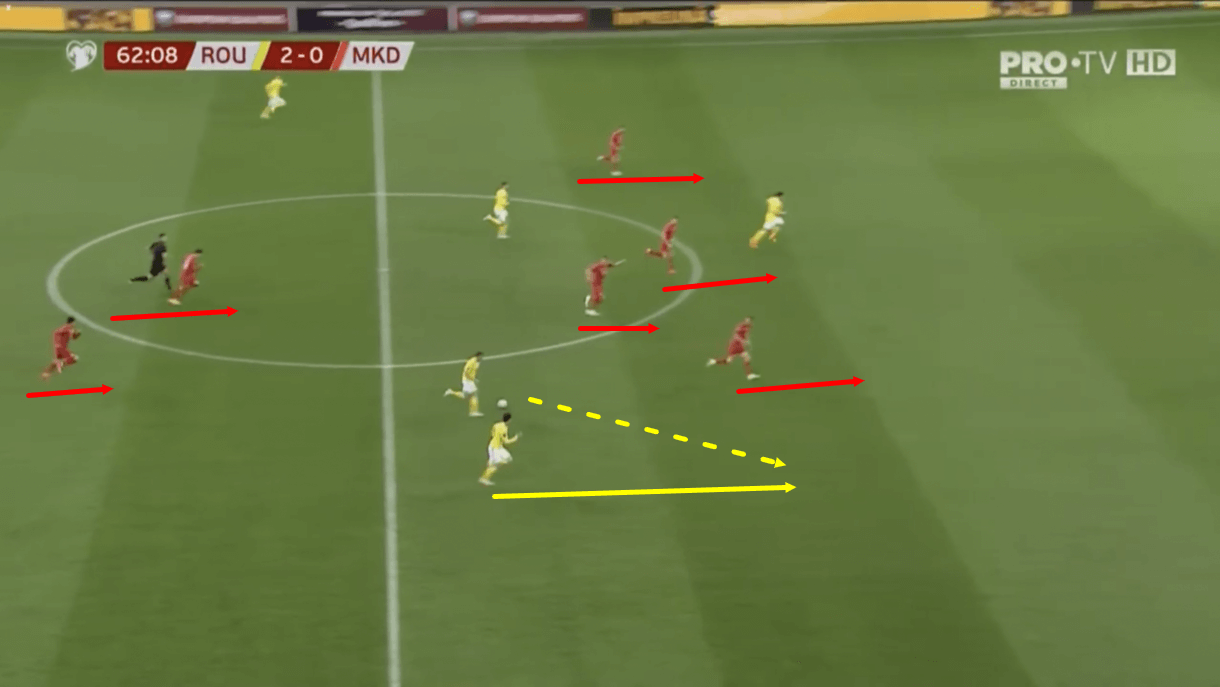
North Macedonia can be exploited in transition to defence, with figure 9 showing how. As mentioned previously, this team’s centre-backs don’t particularly like defending 1v1 but in transition to defence, if the opposition get past the midfield line and enjoy space to run at the backline, then the centre-backs can be dragged into 1v1s.
In figure 9, the Romania player on the ball was found in space behind North Macedonia’s 8s by a deeper player. Teammates quickly got forward to support him, making runs either side of him and he ultimately played through the man overlapping on his right. As this player gets forward, with North Macedonia’s wing-backs caught up the pitch, the right centre-back gets dragged into a 1v1. This isn’t the kind of scenario where North Macedonia thrive, and a goalscoring opportunity was conceded.
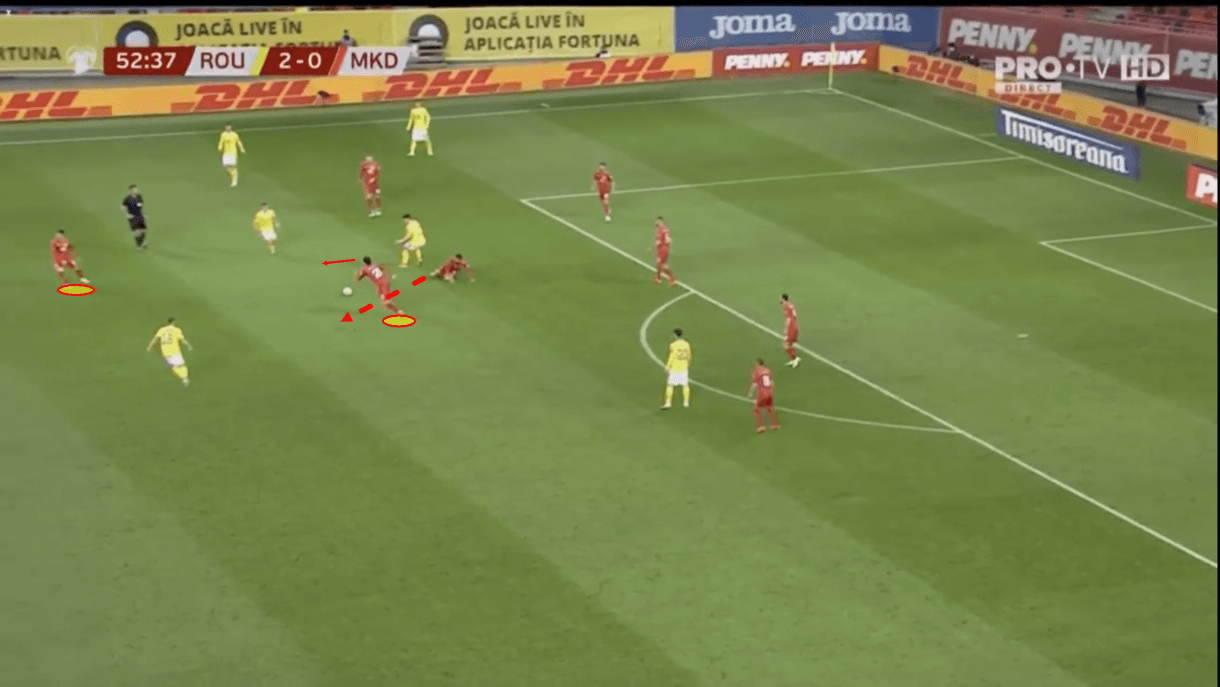
In transition to attack, North Macedonia’s 8s perform a crucial role. Just before figure 10, North Macedonia’s holding midfielder regained possession after the deep, compact defensive shape forced the opposition to play a dangerous pass that allowed a turnover. The holding midfielder immediately played the ball forward to one of the two 8s, and then they used their playmaking quality in this deeper area to get the ball forward. It’s common to see North Macedonia look for one of the two 8s immediately after forcing a turnover to kickstart a counter via their playmaking quality.
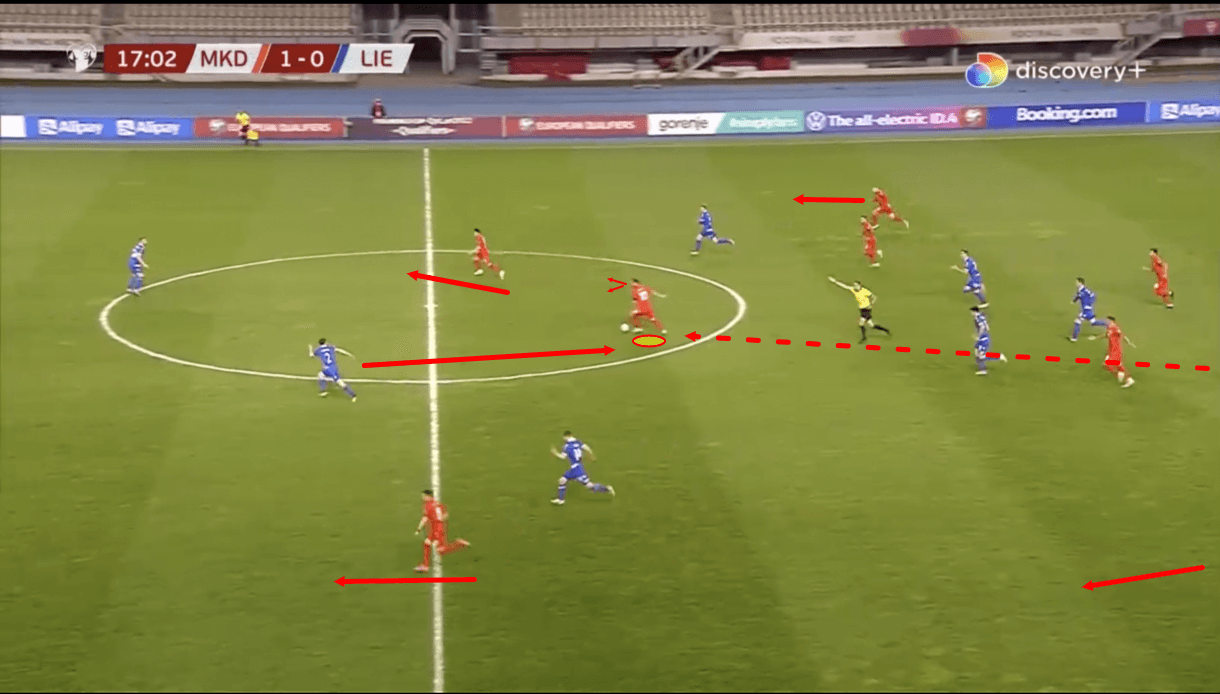
Pandev also plays a key role in transition to attack, as it’s common to see him drop to a slightly deeper ‘number 10’ position, like in figure 11, during counterattacks. He drops between the opposition’s backline and midfield line when his team wins possession to find space. His deeper teammates find him in this position after regaining possession, and he uses his technical quality to turn and play through the runners ahead of him, with the 8s, his strike partner and the wing-backs often bursting forward to provide options.
The 37-year-old isn’t the paciest member of the squad, so on the counter, Angelovski has him perform a role that hides this weakness and emphasises his strengths – reading of the game, movement, and playmaking quality.
FORWARDS
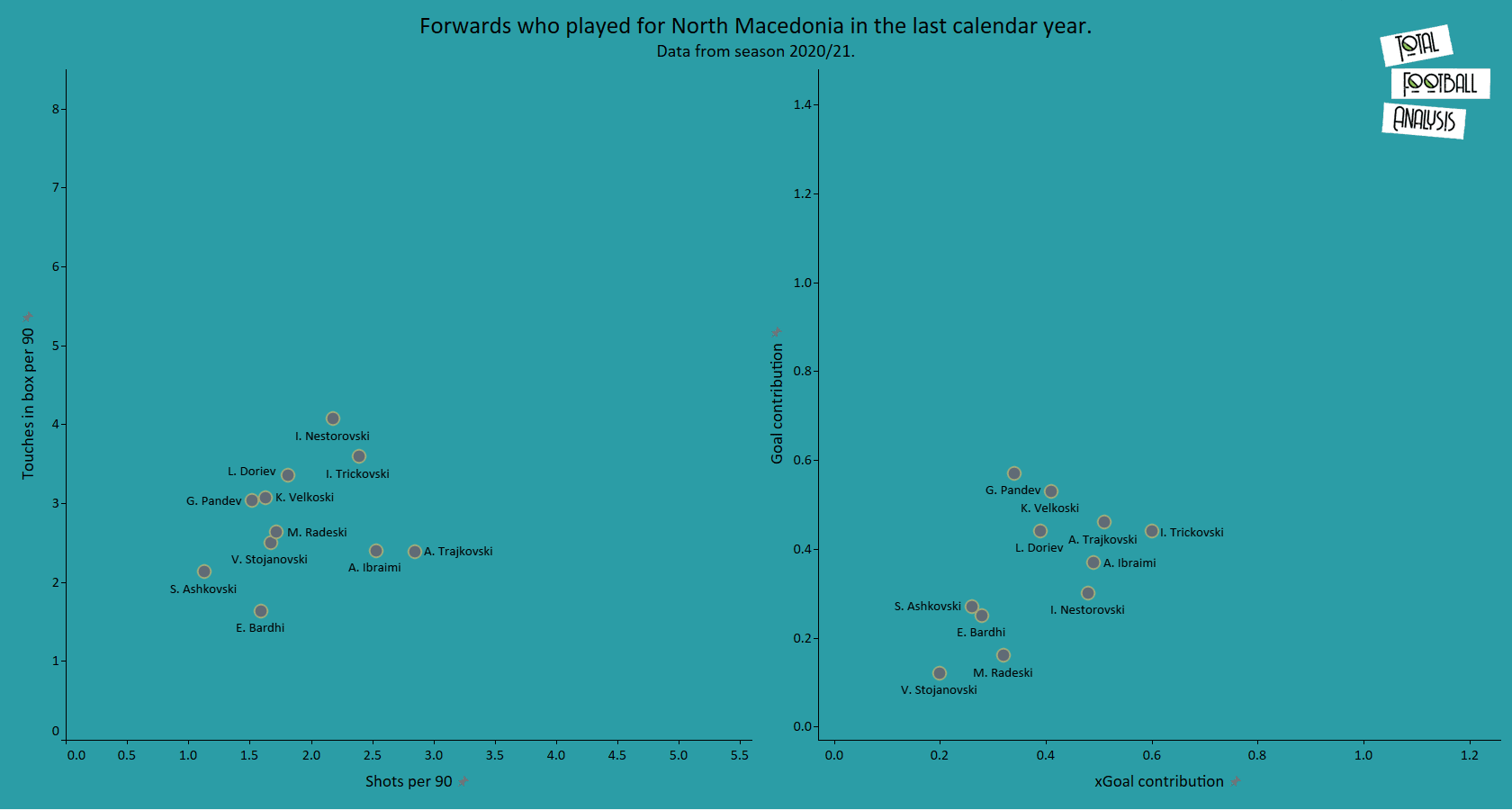
Figure 12 highlights some key statistics for North Macedonia’s attackers. We see from the left-sided graph that Nestorovski and Trickovski tend to take more touches inside the penalty area than both Pandev and Trajkovski – with the former two representing more traditional ‘number 9’ options compared to the latter two.
Despite taking fewer touches in the box per 90 than Nestorovski and Trickovski, Trajkovski takes more shots per 90 than any of the other three main centre-forward options we’ve discussed. Trickovski and Nestorovski operate similarly in this regard, while Pandev takes fewer shots than the others, with the 37-year-old often playing more of a creative role.
However, turning attention to the right-sided graph, Pandev makes more goal contributions than the others despite taking fewer shots – though his xG contribution is lower. Pandev is quite clinical with the chances this team creates, while his teammates are also good at taking the chances he creates.
In contrast, Trickovski and Nestorovski’s xG contribution is greater than their actual goal contribution, indicating that they’re not quite clinical enough in front of goal and/or their teammates aren’t taking the chances they create for them enough. Trajkovski’s goal contribution and xG contribution are roughly on par with one another, indicating that he’s getting as many goals and assists as expected based on the quality of chances he’s creating/getting.
This highlights the crucial role that Pandev plays in this side. He’s a key source of goals and assists, even if the chances he gets/creates aren’t always extremely high quality. With Trajkovski outperforming Nestorovski and Trickovski in this area, it would seem that the best centre-forward pairing for North Macedonia in this tournament will be Pandev and Trajkovski. They will be playing against difficult opposition and as a result, may not get a tonne of chances. So, they must be clinical and the Pandev-Trajkovski duo are that.
MIDFIELDERS
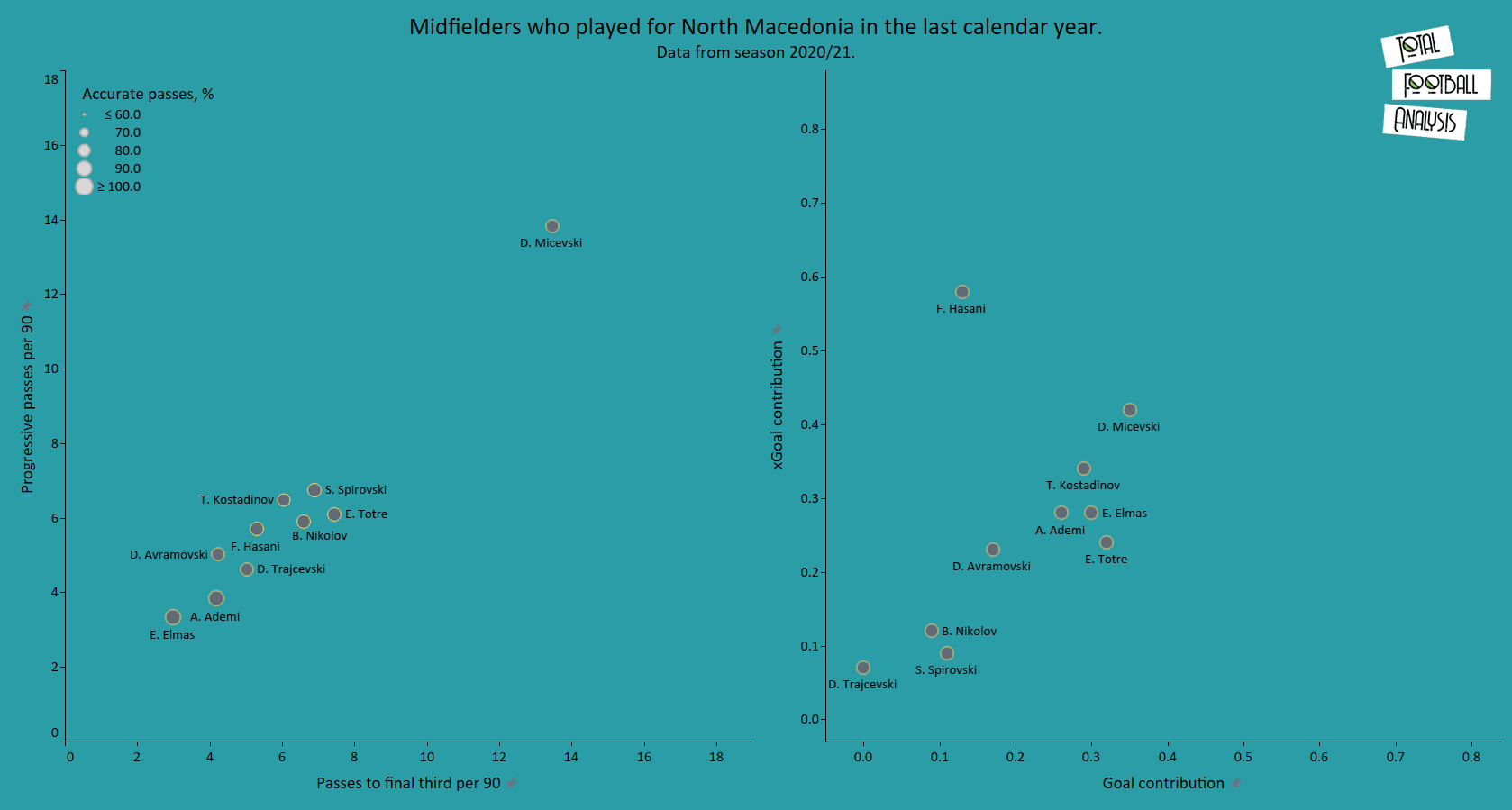
Figure 13 highlights some key statistics for North Macedonia’s midfielders, except for Bardhi who was included in figure 12, due to often playing as a winger at club level with Levante. As a result, we will refer back to figure 12 when discussing Bardhi. Firstly, we’ll use the left-sided graph to compare North Macedonia’s three main holding midfield options – Nikolov, Spirovski, and Ademi. This graph highlights how good these players are at getting their team further up the pitch. Spirovski and Nikolov outperform Ademi in this area based on these numbers, and considering the position they play and the emphasis that is placed on getting the ball forward quickly in attack and transition within North Macedonia’s tactics, this makes the case for Spirovski or, our pick, Nikolov, to start over Ademi.
The right-sided graph highlights goal contributions and xG contributions for North Macedonia’s midfielders, and so, may be more useful for comparing their options for the more advanced central midfield positions. Elmas performs relatively well in both goal contributions and xG contributions, while going back to figure 12, Bardhi’s numbers would place him in a similar range to Elmas, but slightly less impressive, closer to where Ademi falls on this graph. Ferhan Hasani, Darko Micevski, and Tihomir Kostadinov all perform well in terms of xG contribution, and could be useful squad members for Angelovski, especially if he opts for two 8s, but due to the level of competition they play at regularly with their clubs, as well as their suitability for this system, we feel Elmas and Bardhi are likely to be in the starting XI, though this is a position where North Macedonia have some healthy competition.
DEFENDERS
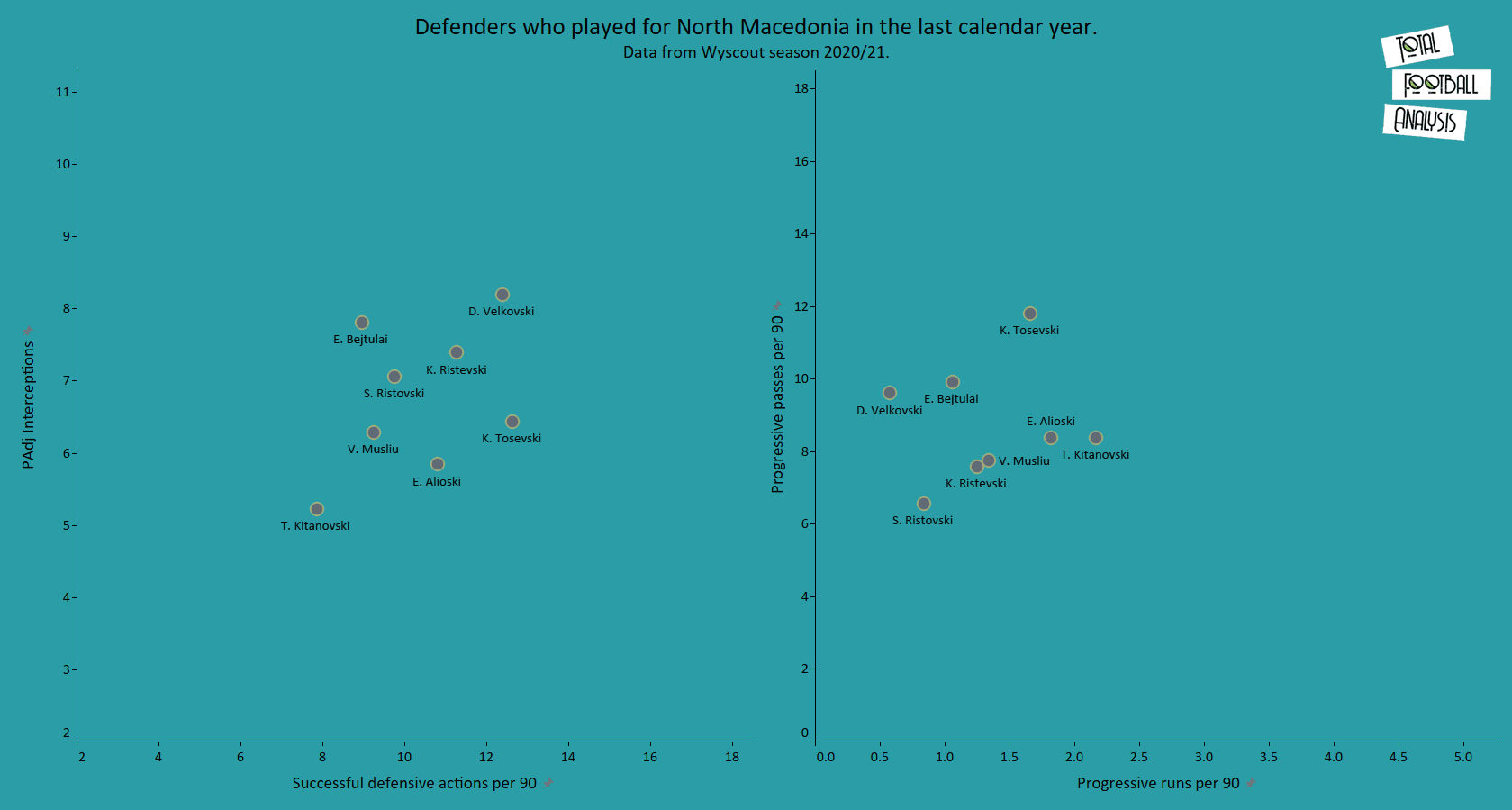
Figure 14 highlights some key statistics for North Macedonia’s centre-backs and wing-backs. Firstly, the left-sided graph tells us how these players fare in terms of their ability to regain possession. One member of our predicted back three, Velkovski, performs very well here, with Ristevski also impressing. Predicted backup Bejtulai performs very well in terms of interceptions, but doesn’t impress as much in defensive actions overall, while Musliu trails the rest of the predicted back three. Kristijan Tosevski stands out for his level of successful defensive actions, and while we don’t anticipate he’ll be part of Angelovski’s starting XI, he may be difficult to leave out of the 26-man squad, and could be useful in one of the centre-back positions.
As for the wing-backs, both Ristovski and Alioski’s performances for defensive actions are positive, though Ristovski’s interception-making ability stands out more than Alioski’s. However, turning our attention to the right-sided graph, which highlights key statistics for ball progression, Alioski makes up for this here. The Leeds United man impresses in terms of his progressive passes and progressive runs. Given the direct nature of this North Macedonia side, and the offensive role that the wing-backs can play, the 29-year-old’s quality in this area could be key for Angelovski’s attack, especially as Ristovski performs relatively poorly in terms of ball progression, so North Macedonia may rely heavily on Alioski to make up for what Ristovski lacks offensively.
As for the centre-backs’ progressive passing, the right-sided graph highlights Velkovski as a standout in this area again, but the other two predicted starters Musliu and Ristevski don’t match up, so Velkovski may be North Macedonia’s key ball progressor from centre-back. Other centre-back options Bejtulai and Tosevski also perform well in progressive passes, however, so Angelovski has got some options, though not as much depth as central midfield.
BEST PERFORMER
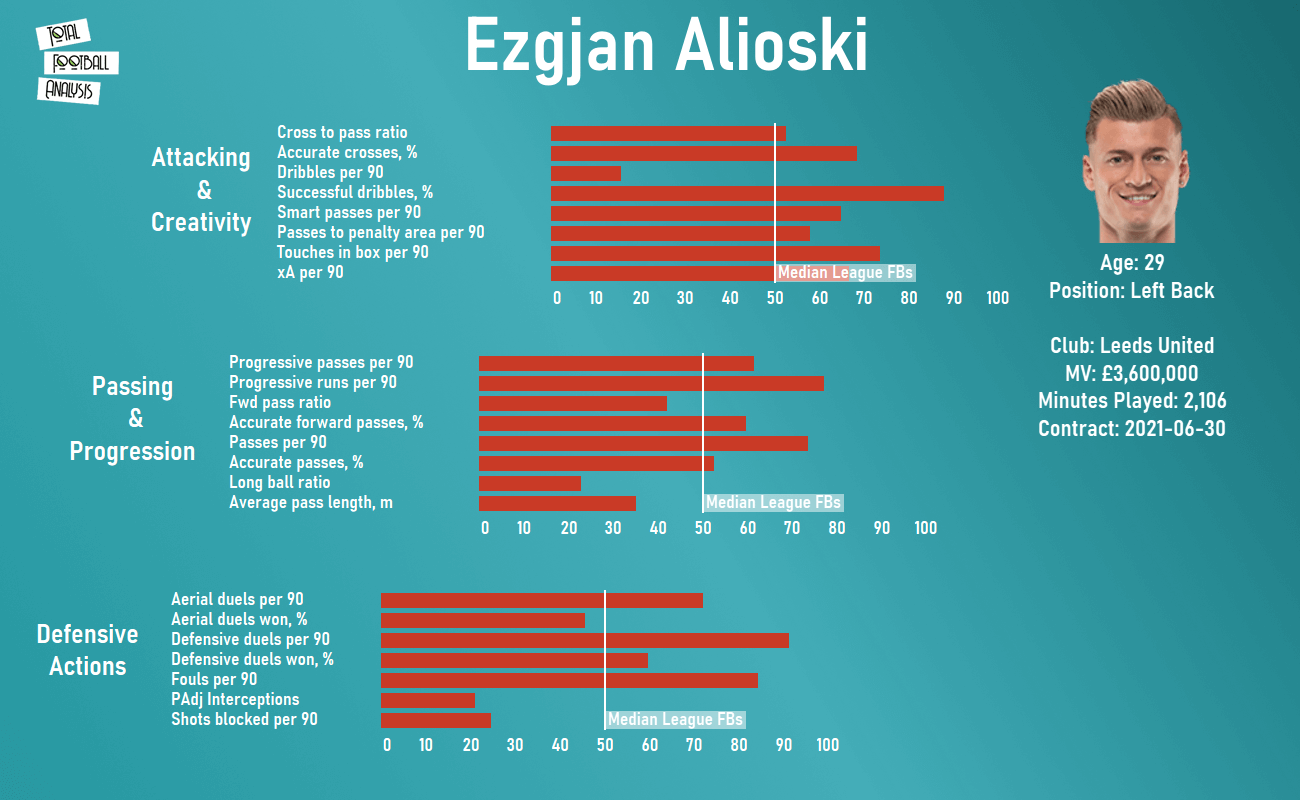
We’ve chosen to highlight Alioski as North Macedonia’s best performer. Alioski is consistently playing at a very high level with Leeds United, and he will likely have to play a prominent role in Angelovski’s North Macedonia squad this summer, especially on the ball. As figure 15 shows, Alioski’s technical quality is one of his greatest assets. He’ll be required to make overlapping runs in attack, and when doing so, he’ll provide a real threat from the wing, as he’s great at making accurate crosses, successful dribbles, getting into the penalty area and creating high-quality goalscoring chances.
As explained in the previous section, Alioski is also a great ball progressor. With right wing-back Ristovski performing less impressively in this area, Alioski may be relied on heavily in getting the ball up the pitch. Lastly, while Alioski’s interception-making ability doesn’t impress, and Ristovski trumps him in this area, he performs very well in terms of defensive duels. He won’t hesitate to tackle an opponent if the opportunity presents itself via North Macedonia’s deep, compact defensive shape and organised defensive tactics, while there’s a strong chance he’ll come out on top of that defensive duel too. For these reasons, he’s a key player for Angelovski’s side.
PREDICTIONS FOR THE TOURNAMENT
Their three group opponents, The Netherlands (16), Austria (23), and Ukraine (24) are all far higher up FIFA’s World Rankings than North Macedonia (62), and while football isn’t all about these rankings, this doesn’t indicate that Angelovski’s men should be optimistic about their chances this summer. However, as their recent win over Germany showed, they’re capable of pulling off upsets against the strongest opposition.
They’ve got players who are capable of winning at the highest level, they’re going to be a very difficult team to break down due to their discipline and their organised defensive tactics, while they’ve also got plenty of creative flair in their side, between the centre-forwards, 8s and Alioski. If Angelovski’s side can successfully exploit space between the opposition’s midfield and defensive lines, then they can create quality goal scoring opportunities. The more they do this, the better their chances will be. Realistically, North Macedonia shouldn’t get out of the group, but we predict they’ll be a tough team to beat and there’s an outside chance they do advance past the group stage, which would be a tremendous win for them in their first Euros.

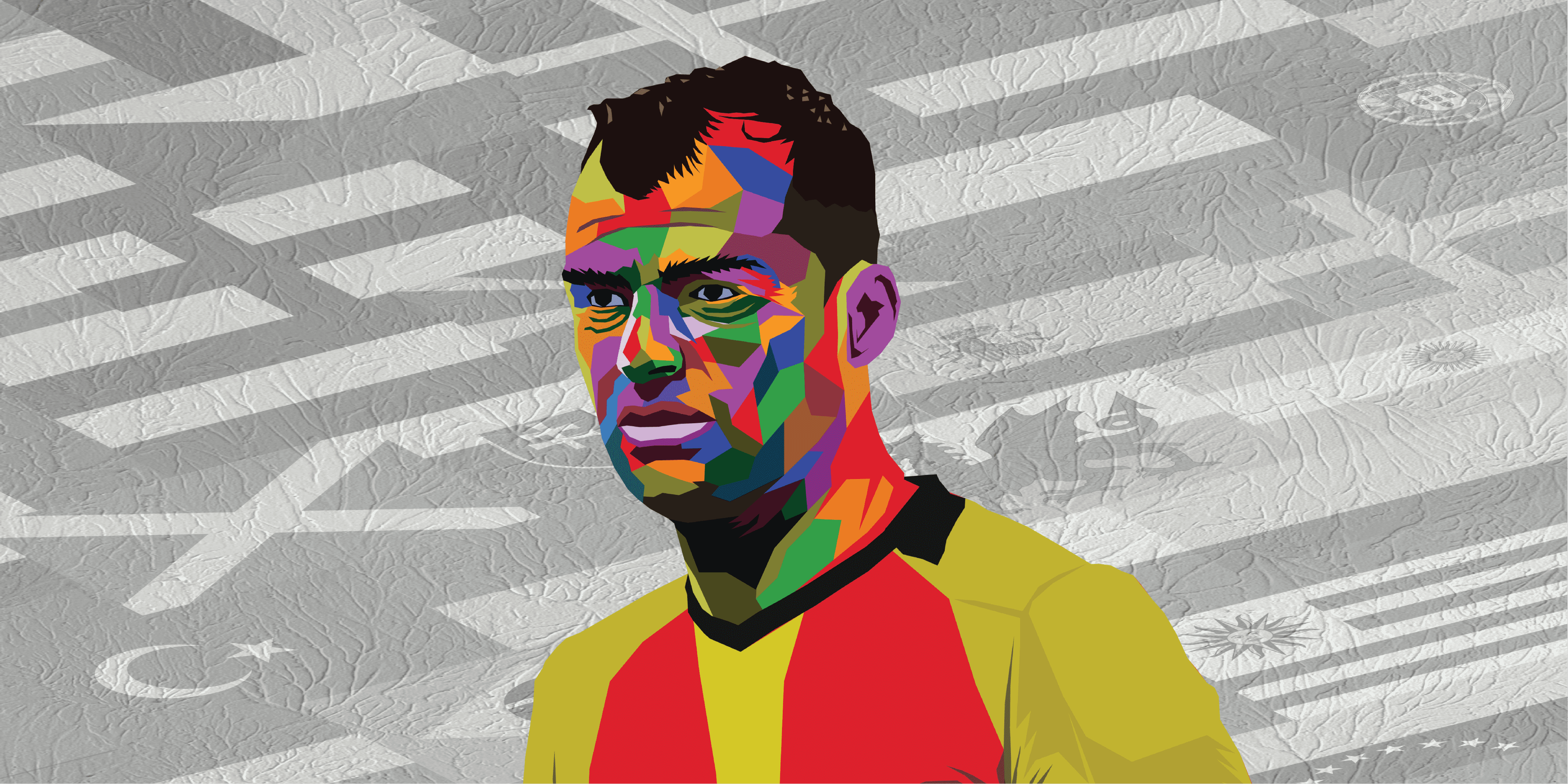
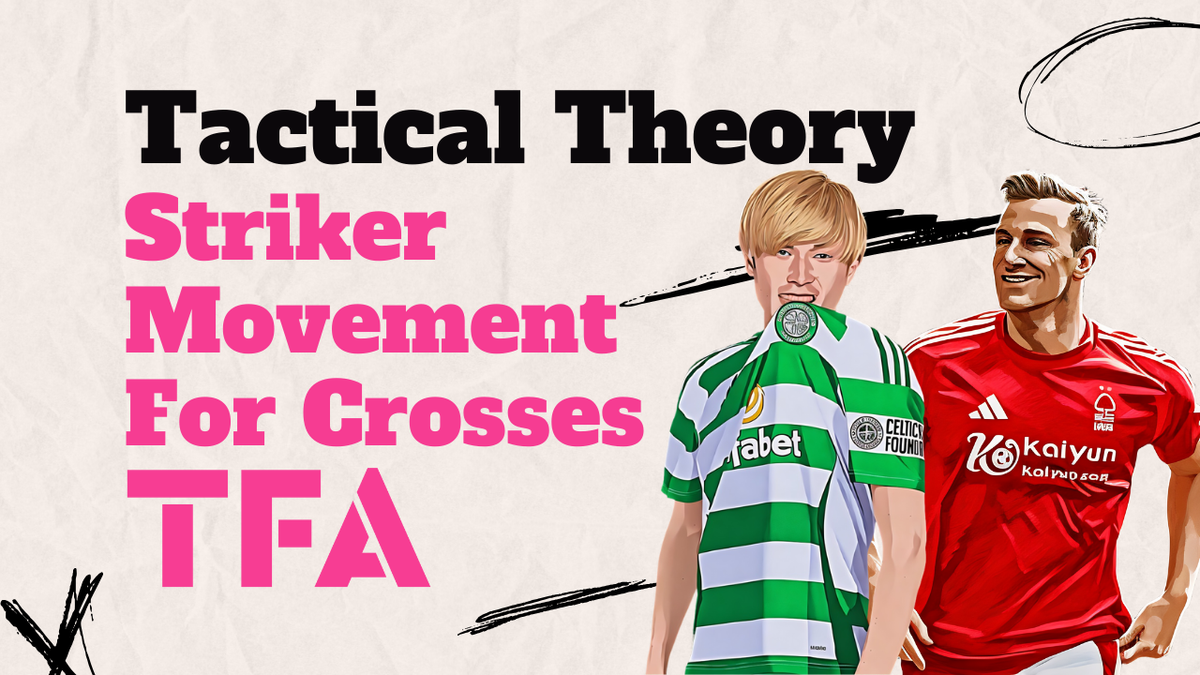
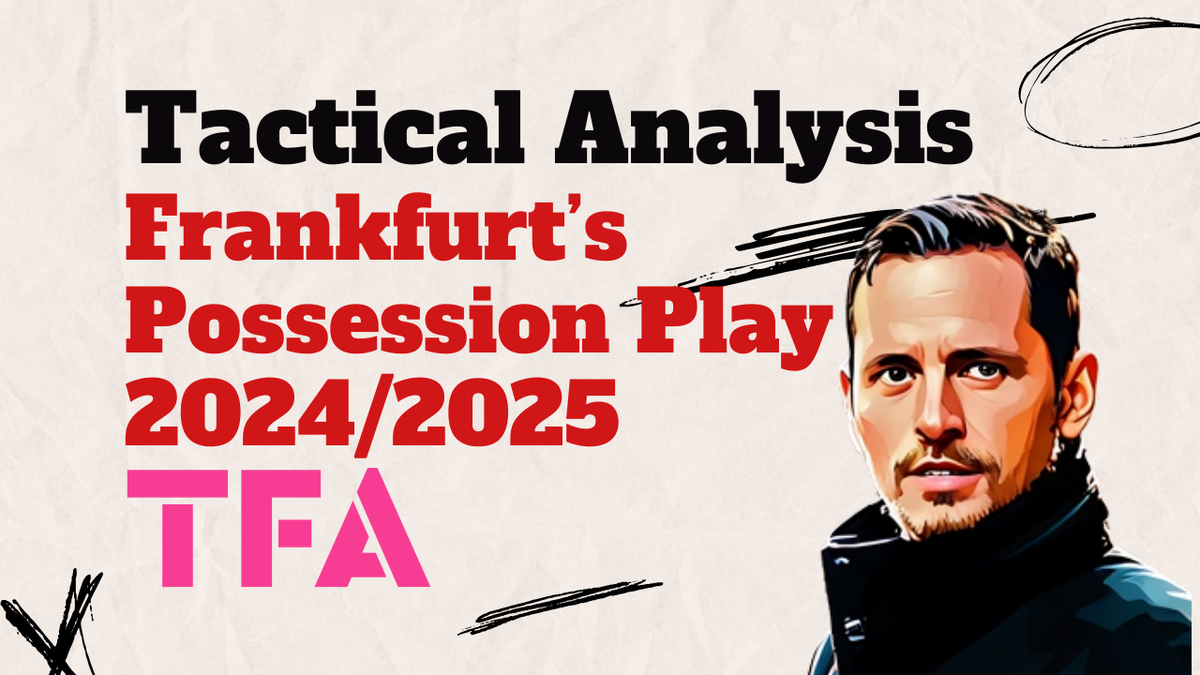
Comments